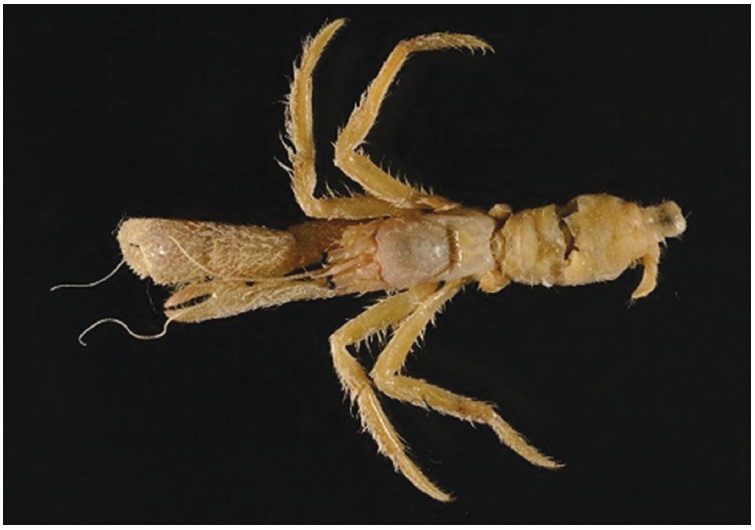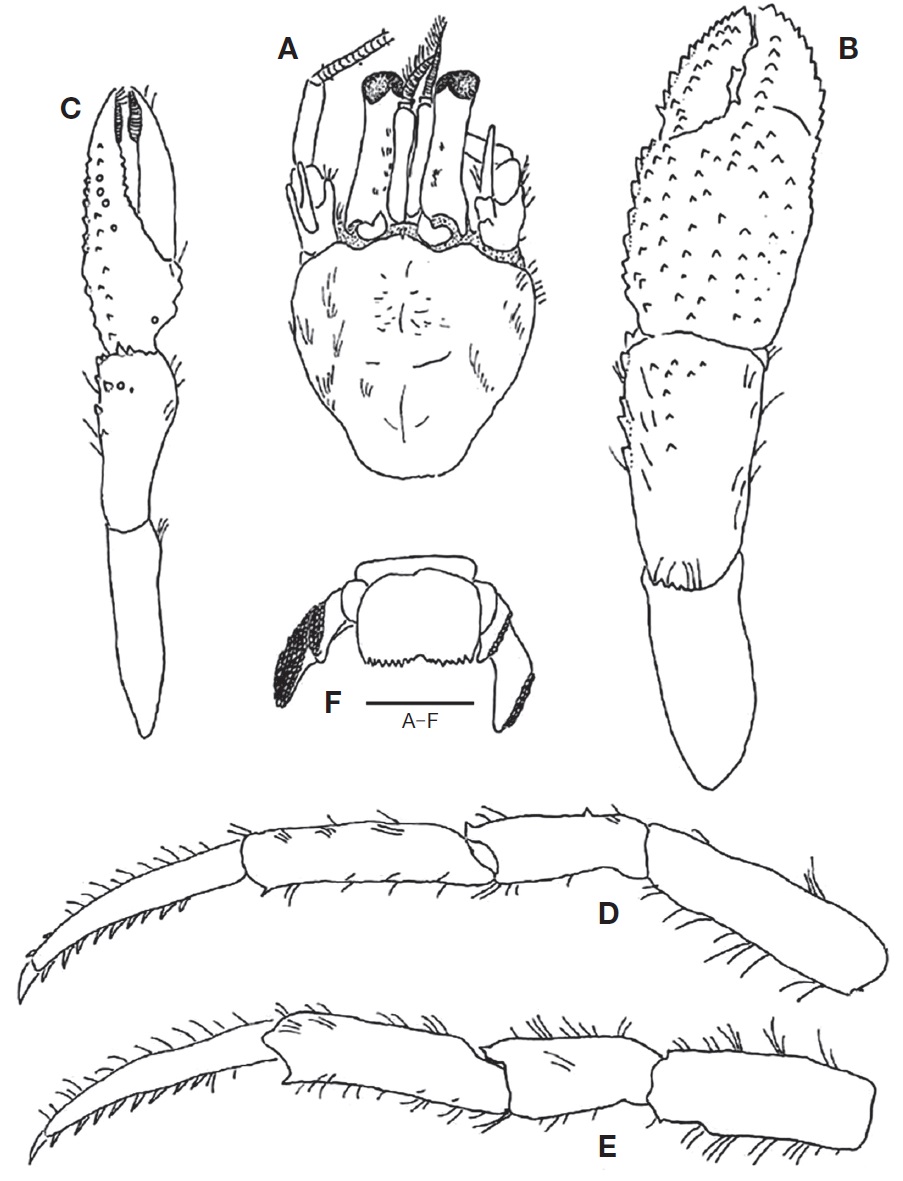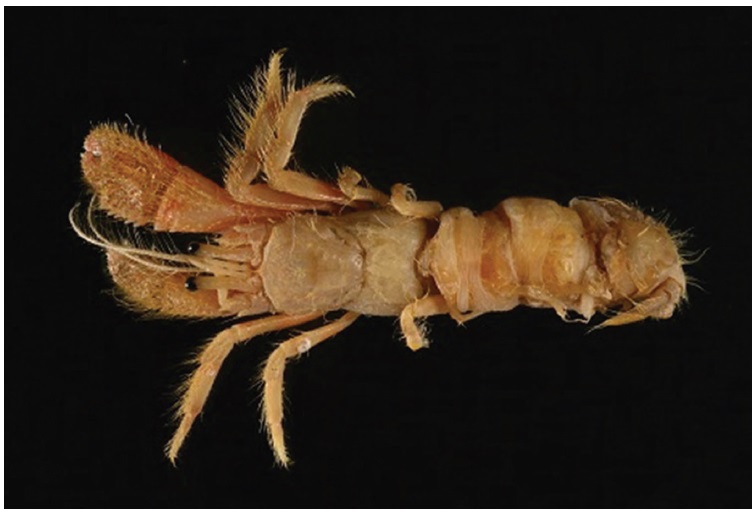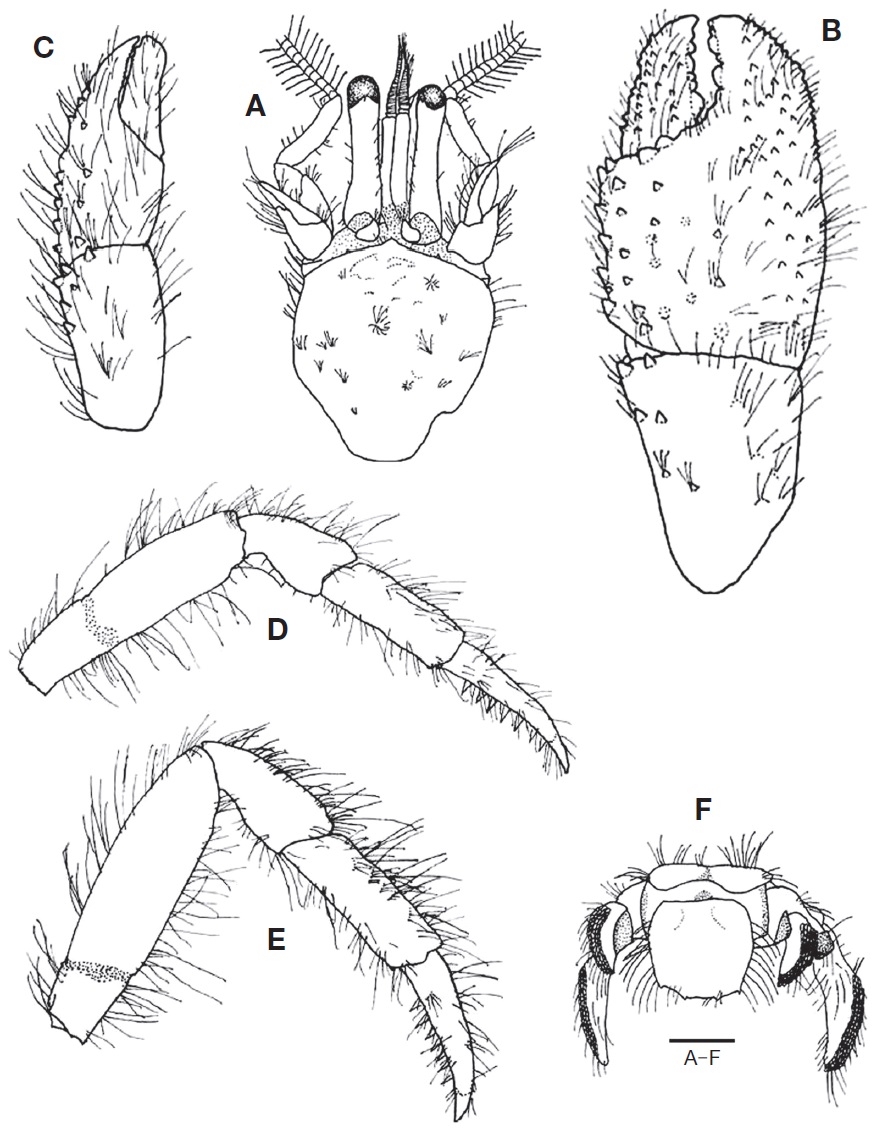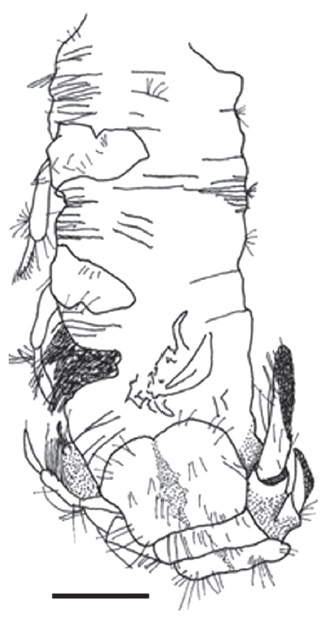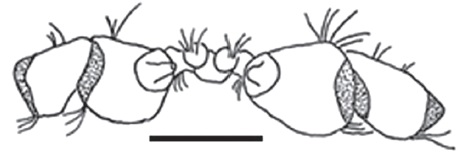



The genus
The samples in this paper were observed using a dissecting microscope (Leica MZ8; Leica, Wetzlar, Germany) and preserved in 72% ethanol and 28% formalin-free fixative concentrate (FineFIX; Milestone, Sorisole, Italy). Figures were drawing with a stereoscopic microscope and camera lucida (Nikon SMZ800; Nikon, Tokyo, Japan). We took photos of the specimens with a digital camera (Nikon D200). The photos advanced with a focus stacking program (Helicon Focus; Helicon Soft Ltd., Kharkov, Ukraine). The shield length (sl) indicates the size of each specimen as measured from the distal tip of the rostrum to the end of the posterior margin of the shield with a slide caliper. The terminology is mostly after McLaughlin et al. (2007). The specimens used in this study were deposited in the Marine Arthropod Depository Bank of Korea, Seoul National University (MADBK).
For comparative study, the following materials were examined:
>
Material examined. 1 ovig.♀ (sl 2.09 mm), Korea: Gangwon-do: Samcheock-si, Port Imwon, 28 Jan 2002, collected by commercial bottom trawl from a tubeworm tube; 2♂♂ (sl 2.84-4.07 mm), 1♀ (sl 2.81 mm), Gangneung-si, Port Jumunjin, 21 May 2002, obtained by netting; 7♂♂ (sl 2.92-5.02 mm), Gangneung-si, Port Jumunjin, 22 May 2002, found by a fishing ship (MADBK160746_001); 1♂ (sl 2.48 mm), Yangyang-gun, Port Namyea, 25 Feb 2003, collected by commercial bottom trawl; 1 ovig.♀ (sl 3.85 mm), Samcheock-si, Port Jangho, 26 Feb 2003 (MADBK160746_002).
Description. Shield (Fig. 2A) slightly longer than broad; rostrum triangular, terminating subacutely; lateral projection triangular, with small submarginal spine. Ocular peduncle 0.7-0.8 times as long as shield; dorsomesial margin with row of setae; cornea not dilated. Antennular peduncle exceeding ocular peduncles by 0.4 times the length of the ultimate segment. Antennal peduncle slightly overreaching distal end of cornea. Antennal flagellum with short setae.
Right cheliped (Fig. 2B) larger than left one, 4-5 times as long as shield. Chela 2.0-2.2 times as long as broad. Dactylus shorter than palm when measured along mesial margin; dorsomesial margin with 2 rows of spines and tufts of setae; dorsal surface with scattered small tubercles and tufts of setae; cutting edge with row of calcareous teeth, terminating in small corneous claw. Dorsal surface of palm slightly convex; dorsomesial margin with row of strong spines; dorsolateral margin with row of small spines; lateral and mesial margins and ventral surface with scattered tufts of setae. Carpus as long as merus; dorsomesial margin with 2 strong spines distally; mesial margin with row of strong spines; dorsal surface with few small spines. Dorsal surface of merus with tufts of long setae; ventral surface with scattered strong spines and tufts of long setae.
Left cheliped (Fig. 2C) reaching to proximal end of right cheliped dactyl. Dactylus longer than palm, all surfaces with tufts of setae, leaving hiatus when closed; cutting edge with row of small corneous teeth. Palm shorter than carpus; dorsal surface convex, with irregular row of small tubercles and some long setae; lateral margin with a few short setae. Carpus nearly as long as merus; dorsal surface with few spines and tufts of setae; dorsolateral margin with a row of spine. Merus slender; dorsal surface almost smooth; ventral surface with row of spines and tufts of long setae.
Second and third pereopods long and slender. Second pereopod (Fig. 2D) shorter than right cheliped by about half of right cheliped dactyl. Dactylus almost as long as propodus; ventral margin with 9-10 strong spines. Dorsal and ventral margins of propodus with long setae; ventral margin bearing 1 spine distally. Carpus with tufts of long setae; dorsal margin of right one bearing 1 spine distally and 1-3 spines proximally, that of left one lacking spines. Merus nearly unarmed.
Dactylus of third pereopod (Fig. 2E) almost as long as propodus; ventral margin with 8-9 strong spines. Dorsal and ventral margins of propodus with long setae; ventral margin bearing 1 spine distally. Carpus partially covered with tufts of long setae; dorsal margin of right one bearing 1 spine distally, that of left one with no spines. Merus with tufts of setae.
Abdomen large, inflated, and mostly straight but slightly curved.
Lateral margin of telson (Fig. 2F) slightly convex, with row of setae; terminal margin concave, with 18-22 small spines. Uropod symmetrical; exopod 1.5-1.7 times as long as telson, slightly curved; endopod stout, shorter than telson.
Distribution. Hokkaido, Japan (type locality); Vostok Bay, Russia; East Sea, Korea (present study).
Habitat. The tube of a polychaete tubeworm.
Remarks. The present specimens of
>
Material examined. 1♂ (sl 4.64 mm), Korea: Gyeongsangnam-do: Geoje-si, Jangseungpo-dong, about 2 km to the northeast (34°52′4″N, 128°44′6″E), 27 Sep 1981, collected by SCUBA diving at a depth of 10-11 m; 1♀ (sl 3.51 mm), Gangwon-do: Goseong-gun, Songjiho, 24 Jun 2010, by SCUBA diving, coll., Park TS (MADBK160747_001); 1♂ (sl 2.09 mm), Gyeongsangnam-do: Namhae-gun, Mijomyeon, Mijo-ri, 8 Aug 2009, collected by SCUBA diving at a depth of 19.8 m, coll., Park TS.
Description. Shield (Fig. 4A) as long as wide; rostrum triangular, terminating subacutely; lateral projection degraded, with small submarginal spine. Ocular peduncle 0.7 times as long as shield; dorsomesial margin with row of setae; corneas not dilated. Antennular peduncle exceeding ocular peduncles by 0.4 times the length of the ultimate segment. Antennal peduncle slightly overreaching the distal end of the corneas. Antennal flagellum with long setae.
Right cheliped (Fig. 4B) larger than left one, 3 times as long as shield. Chela 2 times as long as broad. Dactylus shorter than palm when measured along mesial margin; dorsomesial margin delimited by 2 rows of small spines and tufts of setae; dorsal surface with a few scattered tubercles and tufts of setae; cutting edge with row of calcareous teeth, terminating in a small corneous claw. Dorsal surface of palm slightly convex; lateral and mesial margins with irregular row of small spines and tufts of stiff setae; dorsomesial margin with row of strong spines; dorsolateral margin with row of small spines; lateral and mesial margins and ventral surface with scattered tufts of setae. Carpus as long as merus, wide distally; dorsomesial margin not distinctly delimited, with 2 strong distal spines; dorsal surface with tufts of setae; lateral margin with row of spines. Dorsal surface of merus with tufts of long setae; ventral surface nearly flat, with a few tufts of long setae.
Left cheliped (Fig. 4C) reaching to proximal end of right cheliped dactyl. Dactylus slightly longer than palm; all surfaces with tufts of setae; cutting edge with row of small corneous teeth. Palm shorter than carpus; dorsal surface almost flat, with irregular row of small tubercles and numerous long setae; dorsomesial margin not distinctly delimited; lateral margin with a few short setae. Capus with tufts of setae except ventral surface; dorsolateral margin with 2 strong spines distally; lateral margin with 3 strong spines. Merus with tufts of setae except ventral surface; dorsolateral margin with 4 spines.
Second pereopod (Fig. 4D) stout, shorter than right cheliped by about half of right cheliped dactyl. Dactylus almost as long as propodus; ventral margin with 7-8 strong spines. Propodus nearly unarmed, with long setae on dorsal and ventral margins. Dorsal margin of carpus unarmed, partially covered by tufts of long setae. Merus nearly unarmed. Third pereopod (Fig. 4E) similar to second pereopod in shape and length.
Abdomen (Fig. 5) large, inflated, and mostly straight but slightly curved.
In male, proximal margin of coxa of fifth pereopod (Fig. 6) with sexual tube.
Lateral margin of telson (Fig. 4F) slightly convex, with row of setae; terminal margin convex, with 6 small spines. Uropod symmetrical; exopod 1.5 times as long as telson, slightly curved; endopod stout, shorter than telson.
Coloration. Chelipeds mottled brown. Ocular peduncles pale brown. Pereopods with reddish-brown bands.
Habitat. The tube of a polychaete tubeworm.
Distribution. Uraga Channel and Tokyo Bay, Japan (type locality); East Sea and South Sea, Korea (present study).
Remarks.
Korean Name:1*관참집게속 (신칭), 2*긴관참집게 (신칭) Korean Name:1*관참집게 (신칭)



